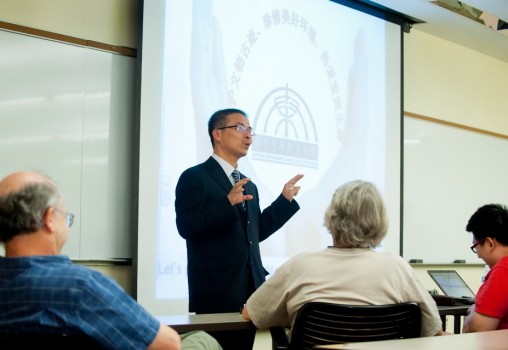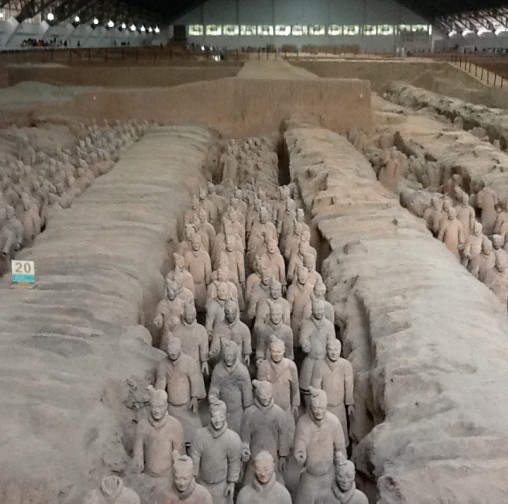
Officials from Museum of Terracotta Soldiers and Horses of Shi-Huang-Di, including Rong Bo, an associate professor and the museum’s vice director of scientific research, made a well-attended presentation to faculty members at Wright State.
Wright State’s partnership with a world-class museum at a spectacular archaeological reserve and mausoleum in China may soon be expanded in the wake of a visit to the university by museum officials.
Officials from the Museum of Terracotta Soldiers and Horses of Shi-Huang-Di were at Wright State from July 23-31 meeting with faculty members to identify disciplines interested in study abroad opportunities and field research experiences at the museum.
Wright State is the only U.S. university with a partnership with the museum, making it possible through a memorandum of understanding signed in 2012. Since then, faculty-led groups of Wright State students have spent time at the museum and archaeological site as part of a four-week study abroad program.
“The students actually got to go down and see and touch the statues, which is an honor that most people don’t get,” said Megan Trickler, coordinator of Wright State’s Education Abroad Program.
The museum is part of an archaeological site and mausoleum in which thousands of terracotta soldiers and other figures depicting the armies of China’s first emperor, Qin Shi Huang, were unearthed. It is believed to be one of the most important findings of the 20th century.
The funerary art was buried with the emperor in 210 to 209 B.C. to protect him in the afterlife and was discovered by some farmers in 1974. The mausoleum is a World Heritage Site, listed by the United Nations, Educational, Scientific and Cultural Organization as of special cultural and/or physical significance. It attracts 5 million visitors a year.
The museum’s labs are working to restore and preserve the terracotta figures, which are made of a clay-based ceramic. Most of the soldiers that were excavated had colors, but the colors can fade quickly when exposed to the air. More than 150 researchers currently work at the site.

The Museum of Terracotta Soldiers and Horses of Shi-Huang-Di near Xi’an, China, features a collection of terracotta sculptures depicting the armies of Qin Shi Huang, the first emperor of China, dating from 3rd century B.C.
During their visit to Wright State, the museum officials — Rong Bo, an associate professor and the museum’s vice director of scientific research; and materials engineer Liang Wang — made a well-attended presentation to faculty members on the museum and the conservation efforts.
“This partnership would allow for other faculty to either take students or to collaborate on research,” said Michelle Streeter-Ferrari, director of Wright State’s University Center for International Education. “It’s a really wonderful opportunity for Wright State to have access to this museum in a way that a lot of other institutions don’t.”
The Wright State Ambassador Program is open to any student on campus and has attracted students studying Chinese, history, business and other disciplines. This year, each student in the China study abroad program received an $800 scholarship to help defray the cost of the trip.
More information is available at wright.edu/ucie/abroad/ambassador.

 Wright State medical students bring medicine to life for Mini University preschoolers
Wright State medical students bring medicine to life for Mini University preschoolers  Wright State Theatre to present rom-com musical ‘The Wedding Singer’
Wright State Theatre to present rom-com musical ‘The Wedding Singer’  Heavy metal learning
Heavy metal learning  State grants to bolster Wright State’s electric vehicle and advanced manufacturing training for students
State grants to bolster Wright State’s electric vehicle and advanced manufacturing training for students  Wright State partners with local universities, hospitals to expand mental health care for students
Wright State partners with local universities, hospitals to expand mental health care for students 